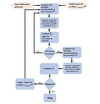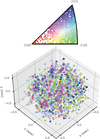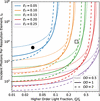issue contents
July 2022 issue

Cover illustration: SyncMRT is a solution to image guided radiotherapy for the Imaging and Medical Beamline at the ANSTO Australian Synchrotron. First, the radiotherapy system is accurately configured and aligned (top) and, using SyncMRT, is calibrated for high-precision alignment (bottom left). Finally, using SyncMRT and standard clinical protocols, a treatment target is aligned to the synchrotron beam with sub-millimetre accuracy (bottom right). See Barnes, Paino, Day, Butler, Haüsermann, Pelliccia and Crosbie, pages 1074–1084).
facility information
research papers
Open  access
access
 access
accessHigh-resolution inelastic X-ray scattering measurements at hard X-ray free-electron lasers coupled with energetic laser drivers have shown a 2.5-fold improved energy resolution compared with previous experiments at similar XFEL instruments. Aspects of the experimental design that can be adjusted to improve the number of recorded photons on the detector are discussed.
Open  access
access
 access
accessSystematic fluctuations in the pulse–pulse intensity profile of a MHz X-ray free-electron laser (FEL) source have been observed that are not described by fundamental FEL theory. The sensitivity of these fluctuations to modifications of the electron-beam orbit in the accelerator is demonstrated as a potential route to beam optimization.
Open  access
access
 access
accessThe efficacy of an automatic technique to align compound refractive lenses at beamline facilities is demonstrated. The algorithm is presented in its entirety, along with the results of numerical simulations and an implementation at the Advanced Photon Source at Argonne National Laboratory, USA.
Open  access
access
 access
accessThe newly constructed time-resolved atomic, molecular and optical science instrument (TMO), configured to take full advantage of both linear accelerators at SLAC National Accelerator Laboratory, the copper accelerator operating at a repetition rate of 120 Hz providing high per-pulse energy as well as the superconducting accelerator operating at a repetition rate of about 1 MHz providing high average intensity, is described.
Open  access
access
 access
accessThe COMIX instrument, a novel compact polarimeter for XUV light based on conical mirrors, has been tested and characterized. Through a time-resolved experiment on a ferrimagnetic thin film, it is shown that the device has the potential to become a versatile tool for research in femtomagnetism.
Open  access
access
 access
accessStudy of interface reaction in a B4C/Cr mirror at elevated temperature using soft X-ray reflectivity
Non-destructive interface characterization of boron carbide shows a significant change at 550°C in the interface region formed between an adhesive chromium layer and native oxide layer on silicon substrate, whereas the principal layer of boron carbide remains stable.
Open  access
access
 access
accessExact analytic descriptions of parabolic, paraboloidal, and parabolic cylindrical X-ray mirrors in a mirror-centered coordinate system for design, modeling, fabrication, and testing are given.
Open  access
access
 access
accessThe derivation of closed-form expressions for ellipsoidal mirror surfaces from the Fermat principle, in terms of the object and image distances, and the glancing angle of incidence, in mirror-centered coordinates is given.
Open  access
access
 access
accessA 0.5 m-long planar superconducting undulator prototype has been developed at the Institute of High Energy Physics in China. The performance of this prototype was investigated based on a vertical test system.
Open  access
access
 access
accessAn industrial robot is being successfully used to position a diffraction detector system at the DIAD beamline at Diamond Light Source. Weighing a total of 139 kg, the detector system can be positioned with a linear repeatability of <19.7 µm and a rotational repeatability of <16.3 µrad. The detector position stays stable for a 12 h period with <10.1 µm of movement for linear displacement, and <3.8 µrad for rotational displacement.
Open  access
access
 access
accessA 3D printed X-ray chamber which allows for in situ exchange of buffer and in situ optical transmission spectroscopy is presented.
Open  access
access
 access
accessThe innovative pressure cell described, suitable for X-ray measurements combining both hydraulic and compressive pressures, is well adapted for studying poromechanical coupling in soft environments.
Open  access
access
 access
accessThe modification of the Langendorff model of the isolated beating heart for microbeam irradiation studies and the results of the first pilot experiment, conducted at the Biomedical and Imaging beamline (IMBL) of the Australian Synchrotron, are reported.
Open  access
access
 access
accessA new approach to compute structure factors, radial distribution function and mean density from liquid scattering data in a pink X-ray source is described.
Open  access
access
 access
accessThree-dimensional X-ray diffraction (3DXRD) has been implemented and demonstrated to be feasible at the I12 JEEP beamline using a single-phase ferritic steel sample. Measurements and associated accuracies of position, orientation and strain state of around 2000 grains were determined. These were obtained from a customized data acquisition and analysis pipeline based on the FABLE software package.
Open  access
access
 access
accessQuantifying sources of error in X-ray transmission measurements provides objective guidance for questions of optimum sample thickness and beamline configuration for higher-order suppression.
Open  access
access
 access
accessThe quantitative relationship between phase-sensitive detection demodulation and difference spectrum is derived and used to quantitatively analyze the electrochemical modulation excitation X-ray absorption spectrum.
Open  access
access
 access
accessA pre-clinical image guidance solution capable of achieving sub-millimetre alignment to the synchrotron beam has been implemented on the Imaging and Medical Beamline (IMBL) at the ANSTO Australian Synchrotron. Our solution, consisting of hardware, software and quality assurance protocols, has become the new standard for all image-guided radiotherapy experiments on the IMBL.
Open  access
access
 access
accessA new dissimilarity metric based on the total variation of the difference map between an image pair is proposed for rigid registration applications. A rigid registration method based on a new metric – total variation of the difference map – is tested and compared with the Fourier analysis-based phase correlation and sum of squared difference metrics.
beamlines
Open  access
access
 access
accessTechnical specifications of the Inner Shell Spectroscopy beamline at the National Synchrotron Light Source II of Brookhaven National Laboratory are described.
Open  access
access
 access
accessThe XAFS/XRF beamline is the first operational beamline at SESAME and in the Middle East. It is a hard X-ray absorption spectroscopy beamline combining the XRF (X-ray fluorescence) and XAFS (X-ray absorption fine structure) techniques that are applied to a broad scientific community.
Open  access
access
 access
accessA multimodal X-ray probe station has been developed and commissioned at the 9C coherent X-ray scattering beamline of the Pohang Light Source-II. Results from the in situ annealing of ZnO thin films and the performance of ZnO nanostructure-based X-ray photodetectors are presented for demonstration.
computer programs
Open  access
access
 access
accessThe Python-based graphical user interface pyXPCSviewer that is deployed at beamline 8-ID-I of the Advanced Photon Source for interactive visualization of X-ray photon correlation spectroscopy results is introduced.
addenda and errata
Open  access
access
 access
accessA PDB code given in Table 2 of Martin-Garcia et al. [J. Synchrotron Rad. (2022). 29, 896–907] is corrected.


 journal menu
journal menu














































